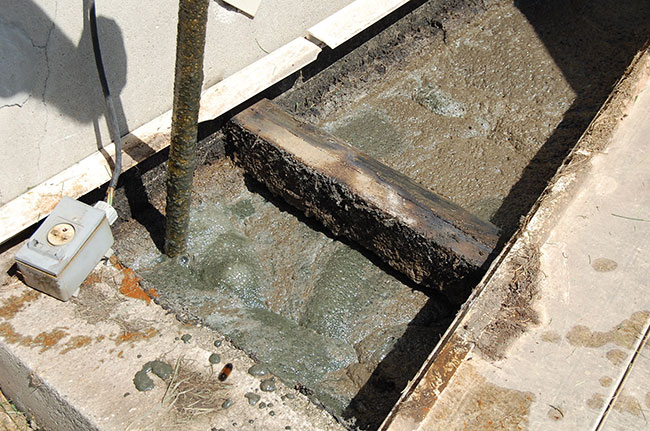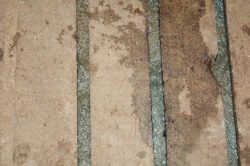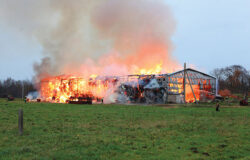
Features
Gas safety
Safety
Storage safety
Stay on top of potential foaming
Manure foaming dangers remain, despite fewer cases.
November 8, 2023 by Richard Kamchen
 Foam accumulated in a pumpout. Foam that is disrupted can release bursts of biogas with methane concentrations of 50 to 70 percent.
All images courtesy of Daniel Andersen
Foam accumulated in a pumpout. Foam that is disrupted can release bursts of biogas with methane concentrations of 50 to 70 percent.
All images courtesy of Daniel Andersen Manure foaming cases have declined in recent years, but don’t take for granted the possibility of spontaneous foaming and its associated dangers.
Foaming on manure surfaces in deep-pit barns can cause asphyxiation, flash fires and even explosions.
“We still see some cases of foaming in manure storages, though not nearly to the level we saw,” says Iowa State University’s manure management expert Daniel Andersen.
The incidence of foaming on the manure surface in deep-pit barns increased significantly starting in 2008, and was the primary cause behind several barn explosions in Minnesota, Iowa and Illinois. In one case back in 2011, an Iowa barn explosion killed 1,500 pigs and injured one worker. Human fatalities have also occurred.
Biogases
Earlier research from now-retired University of Minnesota professors Chuck Clanton and Larry Jacobson found that the risk of flash fires and explosions relates to foam trapping and holding the biogases that are emitted during the anaerobic decomposition of stored manure. If the foam is disrupted, it releases bursts of biogas with methane concentrations of 50 to 70 percent.
When mixed with ambient air, the resulting concentration could be in the explosive range of five to 20 percent, thereby increasing the chances of explosion or flash fire when a heater, motor, or light switch is activated, or someone undertakes repair work like welding, the research has said. Hazardous conditions also occur during agitation, pumping. and pressure washing.
Microbes
Deep-pit swine finishing barns with histories of developing foam typically saw several inches of foam build up, the above research found, with rarer incidents of foam depths exceeding five feet coming up through slatted floors.
Foaming manure will often foam again, whereas non-foaming manure usually won’t start foaming until something changes that triggers a microbial community change, says Andersen.
Foaming and non-foaming manures have different microbial communities, and much of that is related to diet composition, he explains. Diet impacts an animal’s manure characteristics, specifically carbon content, chemical composition, and microbial community.
“The diet generally explains about 50 percent of the microbial community that will develop from clean manure,” says Andersen. “Weather, water amounts, and a host of unknown factors control the other portion.”
Mostly a swine issue

Foam found below slats. Foaming manure will often foam again, whereas non-foaming manure won’t begin until it is triggered somehow.
Although foaming manure is more common with swine, Andersen says he’s seen issues in both dairy and beef barns. But it’s less likely.
For dairy specifically, oftentimes the manure receives enough dilution water added from washing milk house equipment that it doesn’t fall into the range where it’s thick enough to foam.
And generally speaking, cows, as ruminants, digest differently, and are better at digesting fibre than pigs.
That’s an important factor, as pig diets high in fibre – like distiller’s dried grains with solubles (DDGS) – increased the chances of foaming and led to more methane potential, Andersen points out.
DDGS
During the time Andersen undertook his study between 2014 and 2016, the industry had moved forward with adding significantly higher levels of DDGS in rations than before, which he says played a big part in causing foaming to occur.
He explains producers were unknowingly feeding their pigs a diet that they were unable to digest well. These higher fibre diets tended to be less digested by the pig, resulting in more carbon entering the manure storage.
“And since more of it ends up in the manure, we actually get more microbial activity to help break down some of that carbon, more methane, and that led to the foam.”
One of the changes since is improved oil extraction in the processing of DDGS. The oil that’s now extracted was previously embedded in the fibre of DDGS fed to pigs. By separating the oil and then adding it back, it’s much more digestible, and consequently, less carbon ends up in the pit, says Andersen.
Pit treatments
Manure foaming issues peaked in Iowa somewhere around 2012-2013, and since then, they’ve been trending downward then, says Andersen.
That’s partly because of pit treatments like monensin – though Coban 90 is more popular, and Narasin is the swine-approved form, he notes.
“A lot of people are using Narasin, Coban or monensin as a pit additive, and it attacks certain types of bacteria that we saw were more prevalent in foaming barns,” says Andersen.
Also effective has been adding Bacillus bacteria. It’s found in numerous manure treatment products, and is known to make proteoses that help break down the proteins that hold the foam together. A good establishment of Bacillus in a manure pit can therefore lessen the chances of foaming.
He adds, however, that if you start with a dirty pit, in other words, a manure storage with a microbial community established, the existing microbial community will be more resistant to change.
“When we do have foam now, farmers are pretty good about treating it quickly rather than letting the issue developed,” says Andersen.
“Every now and then we’ll see a flare up of issues, but it’s a lot more stable now and not as many people deal with it.”
Ventilation

Although flash fires or barn explosions in deep-pit buildings have fallen, pit foaming can still occur.Photo: Andrius Vaišnoras / adobe stock
Also key to preventing manure foaming is ensuring a barn is well ventilated.
Foaming manures create methane at three times the rate of non-foaming manures, and that means good ventilation is required to remove that methane.
Andersen’s study urges farmers to implement uniform air distribution.
In a room less than 50 feet wide, one pit fan should be operating every 100 feet; rooms greater in size should have fans on both sides every 100 feet.
Also, supplemental heat is required in order to keep an empty barn at temperature, the study reports.
Incidents
Although the frequency of flash fires or barn explosions in deep-pit pig buildings has fallen significantly, manure foaming can still occur, and a 2015 flash fire in a southwestern Minnesota hog barn resulted in two human deaths.
The cases of manure foaming have been far rarer in Canada.
Canadian hog producers reported 13.8 million hogs on their farms on July 1, 2023.
Just over a quarter of those hogs are in Ontario, where several occurrences of manure foaming were reported about a decade ago. But Laura Eastwood, a swine specialist with the Ontario Ministry of Agriculture, Food & Rural Affairs, says she’s unaware of any issues in recent years.
Incidences are practically unheard of in western Canada.
“I’ve been in the western Canadian industry for the last 20 years, and that’s never been a discussion I’ve had with anybody ever,” says a Saskatchewan source.
A Manitoba government spokesperson also reports having no knowledge of any manure foaming incidents. The province accounted for nearly a quarter of Canadian hog inventories on July 1 at 3.3 million, according to Statistics Canada.
The spokesperson relates that manure foaming typically only occurs in barns with deep under-barn pits for manure storage. And while some barns with this type of manure storage exist in both older barns and new builds in Manitoba, none have experienced manure foaming.
“Most of the barns in Manitoba are outdoor steel or earthen manure storages and foaming is not an issue with these types of structures,” the provincial spokesperson adds. •